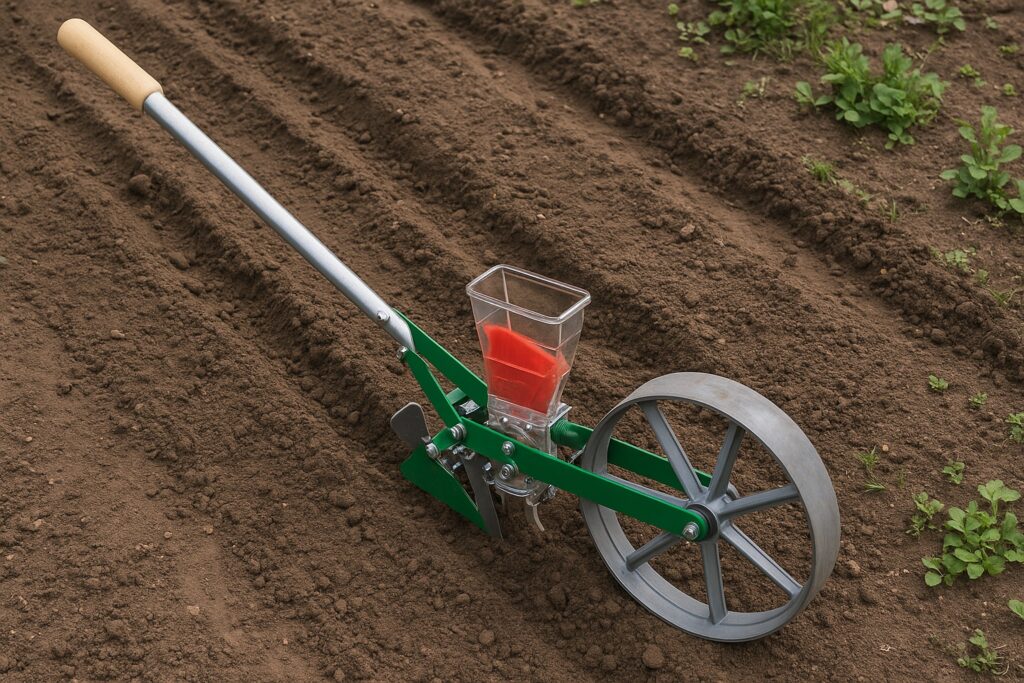Walking into the world of farming tools for the first time is both exciting and overwhelming. There’s a tool for every stage of planting, growing, and harvesting—but few are as deceptively simple yet deeply impactful as the manual seeder. At first glance, it looks straightforward: a lightweight, hand-operated machine designed to drop seeds in rows. But after purchasing and using one myself, I realized there was a lot I didn’t know, and much I wish I had considered beforehand.
Buying a manual seeder might seem like a minor decision, but if you’re serious about small- to medium-scale crop production, it can shape your planting speed, accuracy, and even yield. Whether you’re a home gardener, market farmer, or permaculture enthusiast, knowing what to expect—and what to look out for—can save you time, money, and a good deal of frustration.
First Impressions Can Be Misleading
When I first heard about manual seeders, the pitch was appealing. They promised faster planting, straighter rows, and reduced bending and squatting. The idea of a walk-behind tool that could effortlessly drop seeds at even intervals and the right depth sounded like a dream. What I didn’t fully grasp was that not all seeders are made equal. Just because a product looks good or has decent reviews doesn’t mean it’s the right fit for your specific soil, seed type, or crop density.
In fact, the first model I purchased worked great—on someone else’s farm. My sandy-loam soil was different, and so were the seed sizes I was working with. I quickly found that even small variations in seed diameter could clog the machine or result in uneven drops. While a seeder does save time compared to hand-sowing, a poorly matched model adds its own problems.
This is where I should have taken the time to explore more options and Buy The Best Manual Seeder Machine tailored for the kind of land and seed varieties I was working with. A tool that fits your conditions—not just your budget—is the real investment.
Seed Size Compatibility Isn’t Just a Technical Detail
One of the biggest lessons I learned is that “universal fit” doesn’t always mean truly universal. Some seeders claim to work for everything from carrots to corn, but if you’re serious about uniform spacing and successful germination, that versatility often comes at the cost of precision.
If the seed plates or discs inside the seeder aren’t properly matched to the seed size, you’ll either get skips or doubles—both of which disrupt uniform crop development. For instance, I found that large pumpkin seeds jammed up in a disc designed for peas, while tiny lettuce seeds often came out two or three at a time.
It’s critical to ask whether the machine you’re considering comes with interchangeable seed plates or if accessories are available for different seed sizes. Some high-quality brands even offer custom sizing options for commercial-scale growers.
Soil Type and Terrain Make a Bigger Difference Than You Think
Soil texture isn’t just a concern for planting depth and drainage—it significantly affects how well your seeder works. If your land is full of small rocks or clumps, a lightweight manual seeder will bounce and skip, resulting in missed planting spots. Sandy or loose soil may cause the wheels to sink or drag, while compacted clay can reduce traction and increase resistance.
Due of the seeder’s insufficient weight and wheel grip to manage somewhat uneven ground, I spent more time eliminating soil lumps during my early planting seasons than actually planting. To ensure smooth mobility across your specific field type, it’s worthwhile to check if the model you’ve selected features weighted frames, sturdy wheels, or customisable depth settings.
Incorrect tool-soil matching may result in up to 18% seed loss during planting, according to research from the Sustainable Agriculture Research & Education (SARE) program. Spending additional time researching compatibility before making a purchase is justified by that number alone.
Spacing and Depth Control: Critical, Yet Often Overlooked
A careful balance must be struck between reducing resource competition and increasing yield when it comes to plant spacing. The goal of mechanized planting is defeated, as many manual seeders claim fixed spacing options, but you will still have to spend time correcting manually if these don’t fit your ideal crop layout.
Another unnoticed problem was inconsistent depth control. Seeds won’t be properly buried if the seeder is too light or the furrow opening is too shallow. I would observe seeds exposed on the surface on windy days, which would result in inconsistent germination and crop failure. Adjustability is necessary, not just convenient.
“Good tools make good habits possible. Bad tools waste more than just time, they compromise outcomes.”
Being able to fine-tune the planting depth based on seed type, soil moisture, and even weather conditions changed my entire approach to row planting. Once I upgraded to a model with adjustable settings and metal tines, the difference in seed emergence rates was night and day.
Build Quality and Ergonomics Are Not Secondary Features
I didn’t initially give the handle height, the wheel composition, or even the hopper’s design any thought. However, the weariness in my shoulders and back after planting for a few hours revealed a different tale. Ergonomics are an important concern if you intend to seed multiple beds.
Smoother operation and less physical strain are made possible by manual seeders with adjustable handles, padded grips, or balanced weight distribution. Workflow is accelerated by hoppers that are simple to fill and clean. Steel or rubberized wheels offer superior durability and traction, while plastic wheels may break easily.
Before I had to use an improvised wrench to disassemble a damaged wheel in the middle of the field, I had no idea that some versions even included removable parts for convenient transportation or repairs. I learned my lesson.
Don’t Overlook Maintenance Requirements
Manual seeders require routine maintenance, just like any other farm equipment. Cleaning seed plates is necessary to avoid accumulation, particularly when using coated or pelleted seeds. Every now and again, wheels and axles require lubrication. Switching between seed varieties and plate sizes soon becomes second nature if you’re planting several crops in a single season.
Make sure the seeder you select doesn’t need specific equipment for upkeep or cleaning. Spare parts should ideally be reasonably priced and easily accessible. My succession planting schedule was delayed and my overall yield was impacted when I once had to wait three weeks for a new disk from an overseas supplier.
Keeping a basic kit with backup parts, a brush, and lubricant can extend the life of your machine and reduce downtime during peak planting periods. The FarmHack community offers some excellent open-source tool hacks and modifications for those looking to adapt or repair their equipment locally.
Price vs Value: What You’re Really Paying For
At first, I chose the cheapest model available since I was too concerned with price. However, you get what you pay for in farming, just like in most other trades. Technically speaking, the entry-level seeder worked, but its flaws and limits cost me more in lost seed, replanting, and postponed harvests than I initially saved.
Premium features may be included in higher-end versions, but they frequently pay for themselves through decreased waste, quicker planting, and fewer malfunctions. I would have realised the true worth of originally paying a little more money if I had performed a basic cost analysis, accounting for seed cost, planting time, and maintenance.
FAQs
-
Is a manual seeder worth it for small-scale growers?
Yes, especially if you’re planting more than a few beds regularly. It reduces physical strain, increases row accuracy, and improves seed spacing.
-
Can one manual seeder handle all types of seeds?
Not always. Check if the seeder offers interchangeable seed plates or variable disc sizes. Some models are better suited for small seeds; others handle large or irregular seeds better.
-
What’s the biggest mistake people make when buying a manual seeder?
Assuming all models are the same. Ignoring factors like soil type, seed size, and terrain often leads to poor performance and dissatisfaction.
-
How long does a typical manual seeder last?
With proper care and occasional maintenance, a good manual seeder can last several seasons. Build quality plays a major role in lifespan.
-
Do manual seeders work well on uneven or sloped land?
Not all of them. Choose a model with weighted frames or wide wheels if working on uneven terrain. Lightweight models can skip or misplace seeds.
Where Experience Becomes the Best Teacher
I would test various models, ask more questions, and give my field circumstances more careful thought if I could go back in time. Purchasing a manual seeder is about aligning functionality with your everyday circumstances, not just crossing off an item off your farming list. With the correct seeder, chaos may be turned into clarity and planting can become a seamless, repeatable procedure.
Additionally, the true cost isn’t the money you spend, as most farmers eventually discover. It’s the annoyance, lost time, and crop loss that result from selecting the incorrect tool. If you make this choice correctly, you will be sowing not only seeds but also confidence at every turn.








Leave a Reply